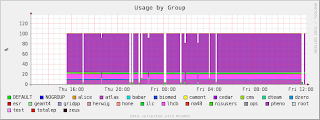The recent
HEP-SysMan workshop was
dedicated to monitoring: what software is available and how to configure it. I was honoured and delighted to be asked to give a presentation on MonAMI.
Well, given the meeting was a "workshop", I wanted to get people working! What better way than a hands-on tutorial: a step-by-step guide that walking you through increasingly more complex examples.
Pete and I had previously started something similar before as a
GridPP wiki page, I wanted to convert this to
DocBook so people had a good looking tutorial to work from. Since I wasn't too sure how long people would take, some extra material was added (e.g. using the MySQL plugin to save monitoring data). It took a surprisingly long time to get the tutorial good, which is one of the reasons things have been so quite recently.
This also
finally forced me to figure out how to produce diagrams of datatrees. Thank's to
GraphViz and some XSLT, the tutorial sports some nice diagrams. (Just need to add some to the user-guide now!)
The logistics were fun. Everyone needed their own environment to play with. Some people were able to used a spare machines at their home institute, but the rest used some 20 virtual machines that Ewan MacMahon managed to throw together. Each VM had its own install of Torque, maui and MySQL. Big thanks to Ewan!
Many people helped in getting this tutorial together. Mike Kenyon, Andrew Elwell, Caitriana Nicholson, Graeme Stewart and Tom Doherty (sorry if I've forgotten anyone!) all helped in proof reading and a big thanks also to Mona Aggarwal for organising the printed versions.
The meeting went well and people were happy with what they were doing.
 Ladies and Gentlemen, MonAMI now has a new output plugin: grmonitor. This allows the latest version of gr_monitor (available from the project's home page) to connect to MonAMI and fetch the data it then plots.
Ladies and Gentlemen, MonAMI now has a new output plugin: grmonitor. This allows the latest version of gr_monitor (available from the project's home page) to connect to MonAMI and fetch the data it then plots.





